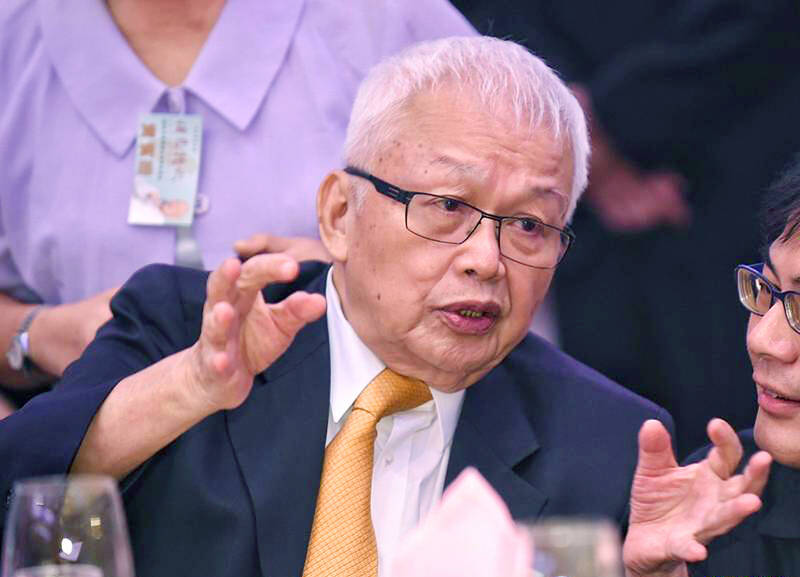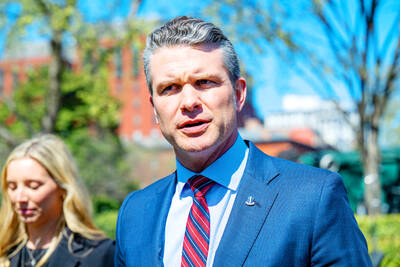The Chinese People’s Liberation Army (PLA) would not be able to launch an invasion of Taiwan for at least another 10 years, Taiwan Research Institute founder Liu Tai-ying (劉泰英) said on Friday.
To occupy Taiwan, China needs to transport at least 300,000 to 400,000 troops across the Taiwan Strait during battle, but it would lack the ability to do so for at least another decade, said Liu, a former Chinese Nationalist Party (KMT) treasurer and a close aide to former president Lee Teng-hui (李登輝).
The challenges that China would face during an attempted invasion of Taiwan would be even greater than those faced by the Allies during the Normandy landings, he said.

Photo: Reuters
The landings during World War II, the largest of their kind in history, involved transporting about 160,000 soldiers from 12 countries, using 6,939 vessels of various types from eight navies across the 33km-wide English Channel, which is much narrower than the 130km-wide Taiwan Strait, he said.
“So where is China now? How many troop-carrying vessels does it have?” he asked.
“If paratroopers were used, the losses for China would be very high, and there are few places on Taiwan proper they could land,” Liu said.

Photo: LibertyTimes
China would also need to take into account that an invasion attempt could lead to another world war, which would likely end in the collapse of the Chinese Communist Party (CCP), he said, adding that Taiwan’s strategic importance means that US involvement in a conflict in the Strait would be inevitable.
US engagement would also likely mean the involvement of the Japan Self-Defense Forces, which, combined with Taiwan’s armed forces, would form a military several times stronger than China’s, he said.
“The US could also potentially use Patriot missiles deployed in Japan, South Korea and Taiwan to intercept any intercontinental ballistic missiles fired at its forces by China,” he said.
“A US drone was used to assassinate senior Iranian general Qasem Soleimani in 2020. The US’ weapons systems and intelligence programs are more sophisticated than China’s and Russia’s,” Liu said.
China’s strategy toward Taiwan is still mainly political in nature, and it seeks to disrupt Taiwanese society and politics by bribing Taiwanese officials, he said, adding that a military conflict would be too costly for China.
While Taiwan’s infrastructure is vulnerable to Chinese missile attacks, the same is true of China’s infrastructure, he said, citing the Three Gorges Dam as an example.
Liu said Taiwanese missiles are capable of striking the dam, “which, if destroyed, would affect up to 600 million people in China.”
“Of course, the CCP realizes what would be at stake in a war, so it would not take the risk,” he said.
In March last year, US Navy Admiral Philip Davidson said that China could invade Taiwan within the next six years.
Other experts have also said tensions across the Strait could put Taiwan in danger by 2027, the centenary of the PLA.

‘DENIAL DEFENSE’: The US would increase its military presence with uncrewed ships, and submarines, while boosting defense in the Indo-Pacific, a Pete Hegseth memo said The US is reorienting its military strategy to focus primarily on deterring a potential Chinese invasion of Taiwan, a memo signed by US Secretary of Defense Pete Hegseth showed. The memo also called on Taiwan to increase its defense spending. The document, known as the “Interim National Defense Strategic Guidance,” was distributed this month and detailed the national defense plans of US President Donald Trump’s administration, an article in the Washington Post said on Saturday. It outlines how the US can prepare for a potential war with China and defend itself from threats in the “near abroad,” including Greenland and the Panama

A magnitude 4.9 earthquake struck off Tainan at 11:47am today, the Central Weather Administration (CWA) said. The hypocenter was 32.3km northeast of Tainan City Hall at a depth of 7.3km, CWA data showed. The intensity of the quake, which gauges the actual effect of a seismic event, measured 4 in Tainan and Chiayi County on Taiwan's seven-tier intensity scale, the data showed. The quake had an intensity of 3 in Chiayi City and County, and Yunlin County, while it was measured as 2 in Kaohsiung, Nantou County, Changhua County, Taitung County and offshore Penghu County, the data showed. There were no immediate reports of

The Chinese Nationalist Party (KMT) is maintaining close ties with Beijing, the Democratic Progressive Party (DPP) said yesterday, hours after a new round of Chinese military drills in the Taiwan Strait began. Political parties in a democracy have a responsibility to be loyal to the nation and defend its sovereignty, DPP spokesman Justin Wu (吳崢) told a news conference in Taipei. His comments came hours after Beijing announced via Chinese state media that the Chinese People’s Liberation Army’s Eastern Theater Command was holding large-scale drills simulating a multi-pronged attack on Taiwan. Contrary to the KMT’s claims that it is staunchly anti-communist, KMT Deputy

RESPONSE: The government would investigate incidents of Taiwanese entertainers in China promoting CCP propaganda online in contravention of the law, the source said Taiwanese entertainers living in China who are found to have contravened cross-strait regulations or collaborated with the Chinese Communist Party (CCP) could be subject to fines, a source said on Sunday. Several Taiwanese entertainers have posted on the social media platform Sina Weibo saying that Taiwan “must be returned” to China, and sharing news articles from Chinese state media. In response, the Mainland Affairs Council (MAC) has asked the Ministry of Culture to investigate whether the entertainers had contravened any laws, and asked for them to be questioned upon their return to Taiwan, an official familiar with the matter said. To curb repeated